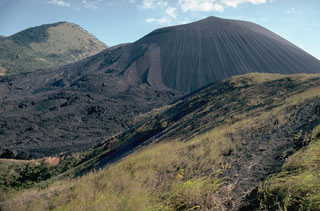Report on Cerro Negro (Nicaragua) — July 2003
Bulletin of the Global Volcanism Network, vol. 28, no. 7 (July 2003)
Managing Editor: Edward Venzke.
Cerro Negro (Nicaragua) Slumbering volcano yields uneventful seismic and fumarolic temperature data
Please cite this report as:
Global Volcanism Program, 2003. Report on Cerro Negro (Nicaragua) (Venzke, E., ed.). Bulletin of the Global Volcanism Network, 28:7. Smithsonian Institution. https://doi.org/10.5479/si.GVP.BGVN200307-344070
Cerro Negro
Nicaragua
12.506°N, 86.702°W; summit elev. 728 m
All times are local (unless otherwise noted)
Seismic activity has been monitored at Cerro Negro for the past 15 months. From April 2002 seismicity remained low with eight earthquakes registered in May and June. Earthquake activity was moderate in August (32), September (28), and October (28); no earthquakes were registered in November or December. Activity increased again in January 2003, when 91 tectonic events were registered. Activity dropped in February to 14 tectonic events but increased again in March (44 tectonic earthquakes, two of which were located underneath Cerro Negro), April (45), and May (41 volcano-tectonic earthquakes). Tremors remained low (5 RSAM units).
Gas emissions and fumarole temperatures measured by hand-held infrared instrument (table 3) were also monitored over this period. A visit on 12 April 2002 by Pedro Perez of INETER, Eliecer Duarte and Eric Fernandez of OVSICORI-UNA, Costa Rica, and Franco Tassi and Orlando Vaselli of the University of Florence, Italy, found that fumarole temperatures were down from February. Monthly visits to the volcano started in June 2002.
Table 3. Temperatures (°C) of fumaroles (identified by number) at Cerro Negro, June 2002-May 2003. Fumaroles 2-4 are in the crater formed in 1995. Courtesy of INETER.
| Date | Fumarole 1 | Fumarole 2 | Fumarole 3 | Fumarole 4 | Fumarole 6 | Fumarole 7 | Fumarole 8 |
| 05 Jun 2002 | 252 | -- | -- | -- | -- | -- | -- |
| 28 Aug 2002 | 255 | -- | -- | -- | -- | 184 | 189 |
| 09 Sep 2002 | 257 | -- | -- | -- | 175 | 184 | 189 |
| 18 Oct 2002 | 326 | -- | -- | -- | 157 | 223 | 188 |
| 21 Nov 2002 | 475 | 564 | 245 | 475 | -- | -- | -- |
| 22 Nov 2002 | 448 | 479 | 200 | 207 | -- | -- | -- |
| 05 Dec 2002 | 403 | 508 | 385 | 208 | -- | -- | 316 / 278 |
| 09 Jan 2003 | 402 | 486 | 494 | 402 | -- | -- | -- |
| 10 Feb 2003 | 402 | 486 | 494 | 402 | -- | -- | -- |
| 21 Mar 2003 | 468 | -- | -- | -- | -- | -- | -- |
| 04 Apr 2003 | 388 | -- | -- | -- | -- | -- | -- |
| 03 May 2003 | 399 | 78.6 | 226 | -- | 239 | 203 | 255 |
On 5 June, following heavy rain, steam was observed exiting the fissure SE of the volcano. Observations on 18 July noted abundant gas emissions at all fumaroles and a strong scent of sulfur around the entire crater. Emissions continued on the SE fissure and in Este del Cerro La Mula. On 28 August, Perez observed gas emissions at fumarole 4 and a continued sulfur odor. Falling rocks were observed in the inner crater. Few gas emissions were observed on 9 September and 18 October, but the strong scent of sulfur persisted. No landslides were observed. Gas emissions were observed at the fumaroles of Este del Cerro La Mula with greater abundance than in previous months.
Perez visited again on 21 November and during 25-27 November, accompanied by Matthias Frische, Kris Garofalo, Thor Hansten, and Boo Gall (GEOMAR Germany). The maximum measured temperature in the new crater was 564°C and for fumarole 1 of the old crater the temperature was 334°C.
The sampling that began in November continued in the following months. On 5 December temperatures continued to be high in the cone formed in 1995. The maximum fumarole temperature on the new cone was 494°C. The visit on 10 February included more sampling, but no physical change was observed at the volcano. Recorded temperatures did not vary from those made in January. Temperature measurements at fumarole 1 on 21 March 2003 revealed an increase of 66°C from February. On 30 and 31 March there was a slight increase of 20 RSAM units and officials observed the volcano for several hours, witnessing no anomolies. On 4 April more temperature measurements and gas sampling were performed and rock was noted to be loosening in fumarole 4. On 3 May the temperatures of the fumaroles located within the crater were constant with respect to the previous months, with the exception of fumarole 6, which had an increase of 100°C. Strong gas emissions were observed in parts of the inner crater.
Geological Summary. Nicaragua's youngest volcano, Cerro Negro, was created following an eruption that began in April 1850 about 2 km NW of the summit of Las Pilas volcano. It is the largest, southernmost, and most recent of a group of four youthful cinder cones constructed along a NNW-SSE-trending line in the central Marrabios Range. Strombolian-to-subplinian eruptions at intervals of a few years to several decades have constructed a roughly 250-m-high basaltic cone and an associated lava field constrained by topography to extend primarily NE and SW. Cone and crater morphology have varied significantly during its short eruptive history. Although it lies in a relatively unpopulated area, occasional heavy ashfalls have damaged crops and buildings.
Information Contacts: Pedro Perez, Armando Saballos, and Aduardo Mayorga, Instituto Nicaragüense de Estudios Territoriales (INETER), Apartado 1761, Managua, Nicaragua (URL: http://www.ineter.gob.ni/).

